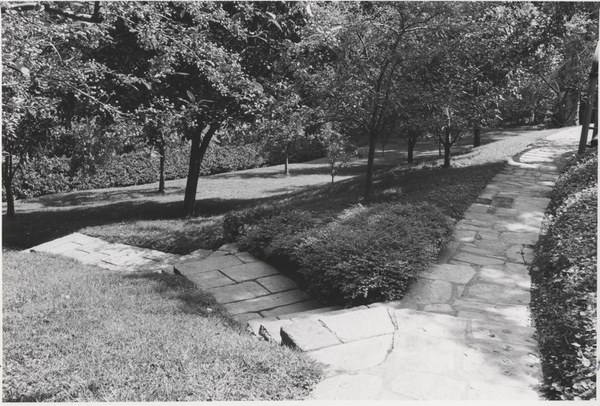The Orchard is planted on a hillside north of the Arbor Terrace, where the land drops dramatically to meet the Herbaceous Borders and Kitchen Gardens in the north. When the Blisses purchased the property, the hillside already contained seven apple trees, a peach, and a cherry. Following the conventions of Italian pastoral landscape and Country Place garden design, Beatrix Farrand included the orchard in her overall plan for Dumbarton Oaks. However, her interest was not in the harvest. Farrand replanted the hillside with apple trees chosen for their spring bloom and visual interest. Rather than producing fruit, she wanted an orchard that served a thematic purpose within the garden scheme, all while masking the abrupt steepness of the north-facing hillside. A cypress and lead arbor bench, designed and placed in the Orchard in 1933–34, invited visitors to sit and look down over the carefully crafted vista of apple trees.
Visitors circulated through the Orchard by way of the Goat Trail path. The Goat Trail began at the Urn Terrace, curved northeast toward the Arbor Terrace, and finally cut through the Orchard, where it branched toward the Herbaceous Border in the north and Mélisande’s Allée in the east. In the Plant Book for Dumbarton Oaks, Beatrix Farrand called this curving stairway an informal “utility walk.” Designing in the Arts and Crafts style, she built a rustic retaining wall and rough flagstone-paved steps. Farrand framed the path with jasmine, honeysuckle, and masses of spring bulbs under the fruit trees along the walkway.
The portion of the path that led from the top of the hill to the Arbor Terrace was particularly steep and curved sharply. The steps coming down the hillside were convenient and provided a good vantage point for overlooking the Orchard, however, they proved to be dangerously steep. In 1946, Farrand advised on a project to repave the steps, in an effort to make the pathway safer for garden visitors. The flagstones were replaced and the grade of the stairway was softened.
When Harvard University took over the institution in the 1940s, Farrand’s vision for the Orchard evolved. With scholars and staff occupying Dumbarton Oaks year round, Farrand saw the Orchard as providing a much-needed source of food. She recommended in her Plant Book for Dumbarton Oaks that the existing trees be replaced over time with crabapples, which would provide spring blooms as well as fruit for preserves and jellies. The need for fresh fruit on premises never reached the levels Farrand anticipated, but her suggestion still went into effect. In the 1960s and 1970s, under the direction of Ralph Griswold, the Orchard was replanted in neat rows of crabapples. Although the crabapples weren’t needed for food, the substitution helped discourage visitors—especially children—from climbing in the Orchard, searching for fruit.

